Search
Berkeley Whole Frog Project: Virtual Frog Dissection Kit
Details
Activity Description
Preparation
- Make sure that the site is not blocked at your school.
- Follow the tutorial steps .
- Play the game and learn how the points are given.
How-To
- Explain that the students will explore the anatomy of the frog.
- Select the link to the Virtual Frog Dissection Kit, and then the image of the frog.
- From here you can choose to show or hide each of the organs, and see a definition of each organ by selecting it.
- Get to know all the organs and their functions.
- Go back to the home page of the Frog Dissection Kit and choose the Virtual Frog Builder game. Here you can build your own frog, and you will test your knowledge of where each organ is located.
- There are also links to other frog resources .
Teacher Tips
Teacher Tips:
Use the Inner Body site to compare with the human anatomy. You will need to scroll down past the ad to see the Inner Body content and select one of the systems to see it in detail.
Program Areas
- ASE: High School Diploma
Lesson Plan
Objective: Activate prior knowledge about animal anatomy and introduce the concept of virtual dissection.
Activity:
- Ask: What do you already know about frog anatomy?
- Display an image of a frog and prompt a brief class discussion:
- Why do scientists dissect frogs?
- How might a virtual dissection differ from a real one?
Optional Hook:
Play a short introductory video about amphibians or frog life cycles.
Objective: Familiarize students with the Virtual Frog Dissection Kit interface and learning goals.
Instructions:
- Explain the purpose of the Virtual Frog Dissection activity.
- Review key vocabulary: anatomy, organ, dissection, function.
- Demonstrate how to access and navigate the site:
froggy.lbl.gov Virtual Frog Dissection - Show how to toggle organs on/off and how to read definitions.
- Mention that they will later play a frog-building game to test their knowledge.
Objective: Guide students through a digital exploration of frog anatomy.
Activity:
In small groups or individually:
- Explore the dissection interface.
- Identify key organs: heart, liver, lungs, intestines, kidneys, etc.
- Click on each organ to learn its function.
- Complete a digital worksheet or journal:
- Name of organ
- Function
- Comparison to a human organ
Objective: Reinforce learning by applying knowledge.
Activity:
- Navigate back to the home page and open the Virtual Frog Builder Game.
- Students attempt to place organs into a frog’s body correctly.
- Points are awarded based on accuracy.
- Optional: Friendly competition between pairs to see who scores the highest.
Objective: Assess understanding of frog anatomy and learning objectives.
Options:
- Use a quick exit quiz (e.g., Google Form or Kahoot!) with multiple-choice questions about frog organs and their functions.
- Ask students to compare frog anatomy to human anatomy using Inner Body as a reference.
- Alternatively, students can complete a short written reflection:
- What was the most interesting part of today’s dissection?
- How does the frog's anatomy compare to your own?
Objective: Deepen understanding and connect to broader biology topics.
Assignments:
- Research and present on one frog organ in detail (e.g., the frog’s three-chambered heart vs. the human four-chambered heart).
- Explore another system (e.g., circulatory or digestive) on Inner Body and create a Venn diagram comparing it to the frog.
- Write a short paragraph or draw a diagram about the frog’s role in the ecosystem and how its anatomy supports its survival.
Documents
- Screenshot of the Berkeley Whole Frog Project.png - Screenshot of the Berkeley Whole Frog Project website
Subjects
- Science
- Biology
- General Science
- Health and Life Science
Standards
- Reading
- CCR Anchor 7 - Integrate and evaluate content presented in diverse media and formats, including visually and quantitatively, as well as in words.

